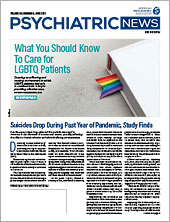Diagnosis is a cornerstone of medical practice, succeeding only to the extent that it provides an accurate roadmap to treatment and, to a lesser extent, outcome. At best it is an imperfect process of applying shorthand labels to complex conditions by subgrouping patients according to their differential treatment needs.
In general medicine, diagnosis has been enhanced through two refinements: accurate staging of illness and accurate understanding of the biology of disease. But even within general medicine, individual variation within classes of patients means that the shorthand doesn’t always work optimally. There is an element of uniqueness about every patient. Judged purely by utility, diagnosis works fairly well in general health care, at least where a range of effective treatments is available, and even if it is not, then for prognostic and palliative purposes.
How about in psychiatry?
The fundamental problem for psychiatry is that diagnosis remains largely syndromal. Syndromes inevitably are produced by a range of causal mechanisms, and conversely each causal mechanism can produce a range of syndromes. Hence the link between the syndrome and the treatment may not be as tight as within more diagnostically evolved domains of medicine. Psychiatry aspires to this more advanced stage but has arguably taken a premature shortcut by equating syndromes (often weakly and polythetically formulated) with discrete diseases. This wishful thinking has created a kind of spurious precision, encouraged by drug regulators who require specific indications for licensing medications.
How can we break out of this straitjacket?
Arguably, clinicians already have, though they are criticized for doing so. This is reflected in the use of multiple medications in patients with a single hierarchical diagnosis and multiple comorbid subsyndromes that clinicians treat with different medications. Derided as polypharmacy, there is a real downside to this approach, and it lacks rigor and a scientific basis. However, at another level, it is responding to a perceived reality, and the notion that any of the current medications are specific to single DSM-defined categories is just not credible. How can we do better?
The first step is to appreciate the complexity of mental disorders and that the distress and psychopathology that we recognize are overdetermined. At one extreme, we have the pure psychotherapeutic stance in which every single person is unique. While it is partly true, it also implies that what we learn about one individual patient cannot be translated to the experience of other patients or to how we as clinicians treat them.
At the other extreme, we have a premature neurobiological reductionism that equates syndromes with diseases; by itself, this reductionism can never do justice to the mind or the social world of the patient. Neurobiology is certainly altered in mental illness, but the changes may be primary or secondary and recovery may be achieved with or without medications. But in every case, a secure therapeutic relationship and psychosocial interventions are necessary, even when medications are essential.
How can diagnosis, which enables subclassification, be refined in a way that really contributes to holistic care of mental illness? Based on my clinical and research experience with people with emerging mental distress and mental illness, a transdiagnostic approach supported by a sequential or clinical staging framework is one part of the answer.
A second pillar of collaboration with the patient is to develop a comprehensive clinical formulation that draws upon the life history and social context of the person. This concept is, of course, by no means new and has been part of the training of psychiatrists and mental health professionals for decades. Yet sadly, health care systems continue to undervalue this and constrain psychiatrists and mental health professionals to a frustratingly narrow professional role and seriously shortchange patients and families.
Staging involves recognition at the point of engagement of where a patient sits along a continuum of (potential) illness progression.
It is an optimistic and preventive conceptual framework, not a deterministic concept, and progression or remission is possible at each stage. A staging approach seeks to proactively reduce the rate of progression to the next stage. Those who don’t progress are sometimes seen as “false positives,” and critics then argue that treatment was unnecessary. However, increasing this false-positive rate can also be seen as an index of success. The chances of remission typically reduce as progression occurs, but remission can still occur at any stage in psychiatric syndromes, including schizophrenia. The other cardinal principle is while almost all effective treatment involves some risk, the benefits must outweigh the risks at each stage. What does this look like in real life?
Since most of the mental disorders that impact across the decades of adult life emerge during the transition from childhood to adulthood (roughly 12 to 25 years), clinical staging works well in youth mental health settings designed for them to guide prevention and early intervention. A focus on young people in this age range has become increasingly important since we have witnessed a global trend for a worsening in their mental health, a trend that is likely to accelerate sharply in the wake of the COVID-19 pandemic for socioeconomic reasons. Over the past decade, youth-friendly and enhanced “one-stop-shop” primary care services for young people have been developed in Australia and a growing number of other high-income countries, and there is growing clinical experience of and exposure to the earliest stage of what may progress to acute mental illness.
The staging model ranges from stage 0 to stage 4. Stage 0 is the pre-illness stage when symptoms and impairment are not present, but there is a variable level of risk or vulnerability. This is the stage when prevention strategies, either universal ones for the whole population or targeted ones for high-risk groups, are indicated.
Stage 1 typically involves emotional distress, with anxiety and lowered mood, resulting in impact on social and educational functioning and often triggered by social or developmental stress such as bullying (stage 1a). Until these new primary youth mental health care services were created, patients at this stage were rarely seen. A subset of these young people (stage 1b) have warning signs of other syndromes, such as psychosis, mania, OCD, or the borderline syndrome. The interventions to be offered at stage 1 are simple: They include problem-solving for immediate stressors and predicaments, emotional and practical support, and monitoring of risk and progress over a period of a few weeks.
A transdiagnostic approach and the largely subsyndromal nature of the psychopathology mean that assigning a specific diagnostic label is not necessary to deliver stage-specific care, and medication is very rarely a first-line option. If the distress, impairment, and need for care do not subside or the warning signs are prominent or worsen, then more intensive psychosocial interventions—notably cognitive-behavioral therapy, dialectical-behavior therapy (DBT), and individual placement and support/vocational support—can be flexibly drawn upon, depending on the complexion of the presenting features. These are still offered from a transdiagnostic perspective, though the emphasis might intuitively shift for a variety of reasons, including patient preference and engagement. The risks of offering treatment in this way to help-seeking individuals with a light diagnostic touch in stigma-free youth primary care settings are greatly outweighed by the risks of not offering care, as well as by the benefits.
Either because they respond to transdiagnostic psychosocial interventions or due to natural remission, fortunately only a minority of stage 1 patients progress to stage 2. Stage 2 is marked by a worsening in severity of one or more of the major syndromes, such as psychosis, depression, mania, borderline syndrome, or other symptom dimension and increasingly impaired functioning, indicating a change in treatment. Hence the threshold for recognizing stage 2 psychosis is the point at which antipsychotic medication is indicated, or in the case of depression, a more intensive psychosocial intervention or the addition of an antidepressant. Ultimately, sequential clinical trials are needed to provide a firmer evidence base for this in several areas. For mania, the transition to a full manic episode would be the indicator that stage 2 had been attained.
Stages 3 and 4 are marked by varying levels of recurrence and persistence of syndromes of increased clarity, one or more of which may have become most prominent or dominant. At this stage, the illness will resemble more traditional diagnostic concepts such as schizophrenia and bipolar disorder. However, even during these later stages, comorbidity is very common, and the early clinical features of anxiety and depression are especially tenacious. The treatment needs of people in these later stages are diverse and involve medications, expert psychosocial care, and high-quality general medical care to prevent and treat these patients for the medical illnesses that they are at very high risk of developing. This preventive mindset for physical illness and premature death must be adopted from stage 1.
Clinical staging in psychiatry aspires to evolve into clinicopathological staging via the inclusion of pathophysiological biomarkers, so that diagnosis can be further refined and personalized. This is a longer-term project, but this objective lies at the heart of the ground-breaking Accelerating Medicines Partnership Schizophrenia Project funded by the National Institute of Mental Health. This project aims to identify promising biological and behavioral markers that can help identify those at risk of developing schizophrenia as early as possible, track the progression of symptoms and other outcomes, and define targets for treatment development. Senior investigators at Orygen, our research institute in Australia, and our global collaborators (including the funders and partners at the National Institute of Mental Health/Foundation for the National Institutes of Health) are proud to be playing a leadership role.
The other way we can personalize care and balance the current limitations of psychiatric diagnosis right now is the clinical formulation, which captures the unique story and context of each patient. This must be developed collaboratively with the patient. The therapeutic process will be further enriched and strengthened if continuity of care, with one or more key mental health professionals, can be assured over time for as long as mental health care is required. Continuity of care is typically given scant regard in most systems of mental health care globally, yet it is the cornerstone upon which diagnosis and treatment rest. ■
References
1.
McGorry PD, van Os J. 2013. Redeeming diagnosis in psychiatry: Timing versus specificity. Lancet 381(9863):343-345.
2.
McGorry PD, Hickie IB (Eds). Clinical Staging in Psychiatry: Making Diagnosis Work for Research and Treatment. Cambridge: Cambridge University Press, 2019.
3.
McGorry PD, Hartmann JA, Spooner R, Nelson B. 2018. Beyond the “at risk mental state” concept: Transitioning to transdiagnostic psychiatry. World Psychiatry 17:133-142.
4.
McGorry PD, Nelson B. 2016. Why we need a transdiagnostic staging approach to emerging psychopathology, early diagnosis, and treatment. JAMA Psychiatry 73:191-192.
5.
McGorry PD, Goldstone SD, Parker AG, Rickwood DJ, Hickie IB. 2014. Cultures for mental health care of young people: An Australian blueprint for reform. Lancet Psychiatry 1:559-568.
6.
Hetrick SE, Bailey AP, Smith KE, Malla A, Mathias S, Singh SP, O’Reilly A, Verma SK, Benoit L, Fleming TM, Moro MR, Rickwood DJ, Duffy J, Eriksen T, Illback R, Fisher CA, McGorry PD. 2017. Integrated (one-stop shop) youth health care: Best available evidence and future directions. Medical Journal of Australia 207(Suppl 10):S5-S18.
7.
Parker AG, Hetrick SE, Jorm AF, Mckinnon AJ, McGorry PD, Yung AR, Scanlan F, Stephens J, Baird S, Moller B, Purcell R. 2016. The effectiveness of simple psychological and physical activity interventions for high prevalence mental health problems in young people: A factorial randomised controlled trial. Journal of Affective Disorders 196:200-209.
8.
McGorry PD, Keshavan M, Goldstone S, Amminger GP, Allott K, Berk M, Garner B, Lavoie S, Pantelis C, Yung AR, Wood S, Hickie IB. 2013. Biomarkers and clinical staging in psychiatry. World Psychiatry 13:211-223.

